Week 25.06 posts include shots from The Manchurian Candidate (1962); Palm Springs (2020); Palm Springs (2020); Palm Springs (2020); and Witness (1985).
Palm Springs
Palm Springs is a groundhog day movie, thus has to show a lot of events over and over and over and over and over and you get the idea.
One way it does this is create a simple image with unique props and strong colour contrast; when the image re-re-re-appears, its colour and absurdity (pizza and donut floats!) keep it from being boring, while still getting across time loop, and the minor variations 'pop' because of the simplicity.
Then when one makes a slightly-bigger-than-usual deviation (final shot) an hour in, it REALLY stands out.

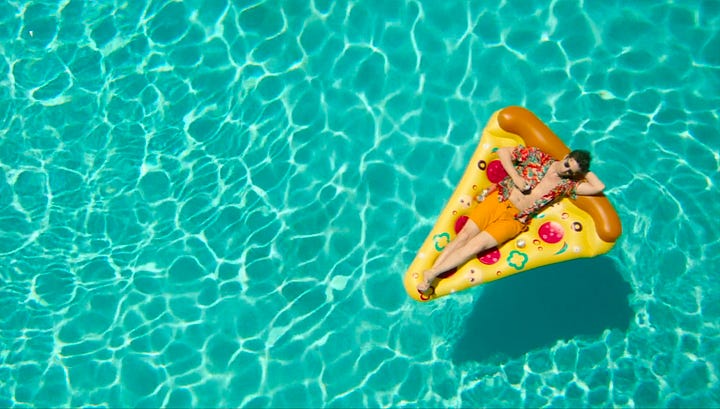
Palm Springs
Let's look at one mini-sequence and how it uses repeating shots to bookend a scene, but makes sure to use a variety of shots within the scene to keep things fresh!
Wide constantly repeated shot: Nyles (Andy Samberg) in the pool, on pizza floatie
CU constantly repeated shot: Nyles's eye opens as we hear 'wake up' - his day has restarted
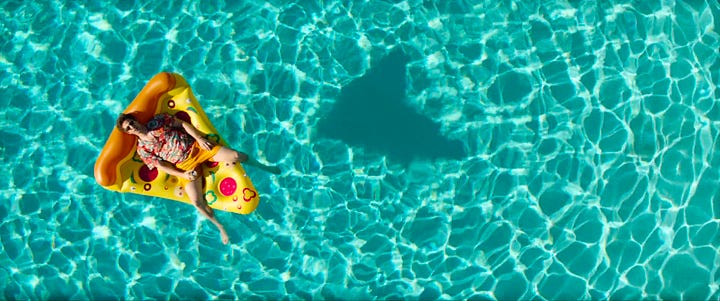

The following scene: top-down of Nyles pouring tequila; dollying-backwards medium-wide of Nyles 'sandwiched' between Pia and Howard; medium of Nyles; single of Pia which keeps her frame-left; medium of Nyles drinking the tequila; single of Howard which keeps him frame-right; medium of Nyles as he leaves frame . . .





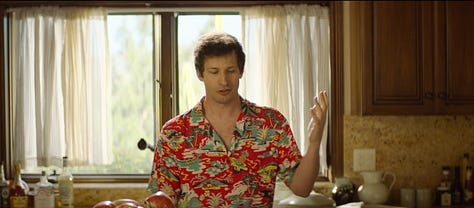
smash-cut to:
Wide constantly repeated shot: Nyles (Andy Samberg) in the pool, on diving board
CU constantly repeated shot: Nyles's eye opens as we hear 'wake up' - his day has restarted and we hear Nyles ask "where is she"
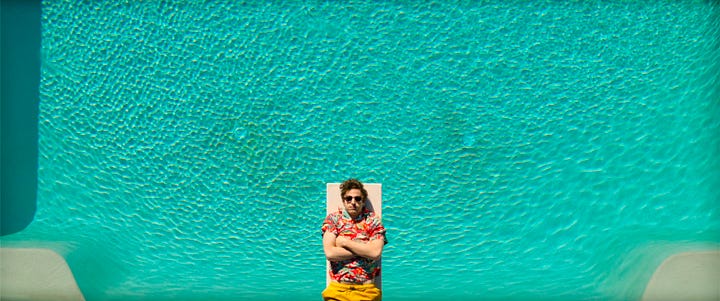

26 seconds tells us all about this particular day-in-the-loop. The only shots which repeat are of Nyles. We don't need a full reverse onto Pia or Howard because the scene isn't about them (essentially, they're there to break up shots of Nyles). We get the gist, it drives home the repetition, but other than the one medium shot and Nyles's eye opening, the rest of the shots change.
All this walks the line of 'being a movie about constant repetition' while staying visually interesting.
Palm Springs
When Sarah (Cristin Milioti) wakes up, almost immediately we get a shot of her looking out the window, then a POV shot of her narrow view through the window.
Sarah rushes out into wedding prep, confused, until she turns and spies Nyles in the pool on his pizza floatie.
Both the shot of her looking out the window and the POV shot of the window are framed similarly to the shot right after she wakes up:
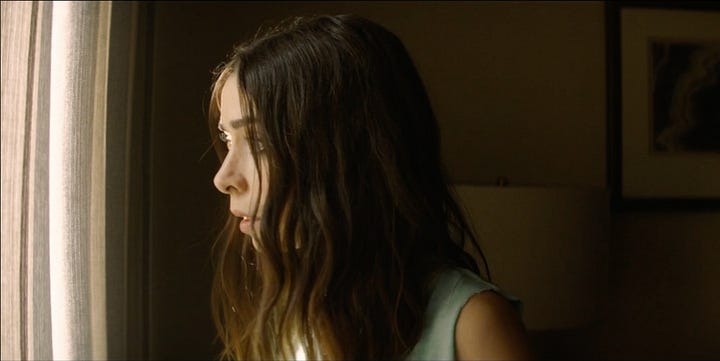
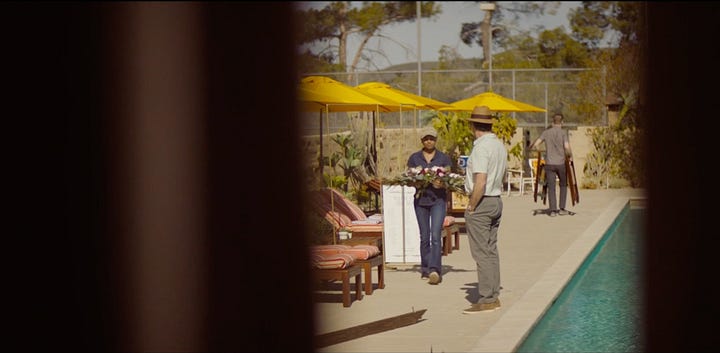


We haven't seen such direct POV shots before this, so using them helps clarify we're 'with' Sarah, and seeing distinct elements (Nyles on a pizza floatie) from yet another angle catches us up to the fact she's joining in his loops already in progress.
Repeating shot-POV-shot framing isn't from lack of imagination, it's because within the chaos of Sarah's confusion, the audience needs clarity. The story hasn't yet established how a time loop for *two* people will work, but repeating similar visuals helps ground us.
Choosing when to tweak the exact same shot, when to introduce wholly new shots, and when to repeat similarly framed shots in new places, are all crucial to Groundhog Day stories.
Palm Springs uses them effectively for shorthand, clarity, and visual interest.
The Manchurian Candidate
Feast your eyes on this mind-bending dream sequence oner from 1962's The Manchurian Candidate - a 'simple' matter of a live stage change, involving almost exactly 60 seconds to reset backdrop, lighting, props, chairs, and some actors, as the camera goes around.
A few elements make it more difficult: extras in the greenhouse (0:12-0:23), plants *everywhere*, water in glass and pitcher, adding a soldier-stenographer with a little table.
Some clever tricks make certain things easier: the stenographer is far-left, thus he can actually already be there, hidden in the first frame! we only think we saw that far side of the stage . . . ; the camera carefully frames out table on the first pass (0:16-0:27) so they can simply use the same table; only one woman speaks, so ADR her speech in post and shout instructions during the filming).
The result is quite trippy, which exactly echos Marco's (Frank Sinatra) experience.
Then a smash to a reverse wide which is wildly different than the row of old ladies that slow oner shows us caps the whole thing with a bit of shock and awe.


Witness
Is there a hotter scene in 1985's Witness?
Well, there's a scene where Rachel Lapp (Kelly McGillis) stares down Detective John Book (Harrison Ford) when he walks in on her bathing. There's also Book drinking lemonade (IYKYK). But this scene gives them a run for their money.
When Book and Rachel give into their desires to touch while fighting the urge to do [so much] more, director Peter Weir moves the camera in semi-circles in the medium shots, then walks it closer in the closeups, so we viscerally experience them getting closer to each other, and to danger.

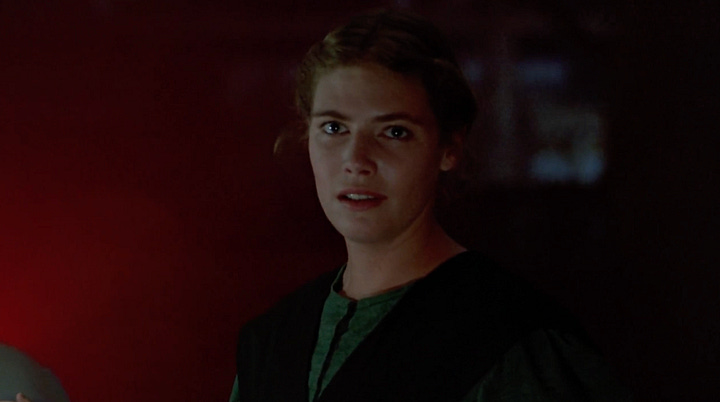
Meanwhile, the scene’s two main, practical light sources — a lantern and car brakelights — highlight Book's hands while casting sexy shadows on his fact and chest, and throw passionate fiery red behind Rachel as Book walks closer, and closer, and closer . . .


Book’s arm around Rachel’s waist as they dance only increases the hotness. If the scene didn't break into that wide shot just as Book breaks away to dampen the tension by dancing solo for a moment, we may all spontaneously combust.





